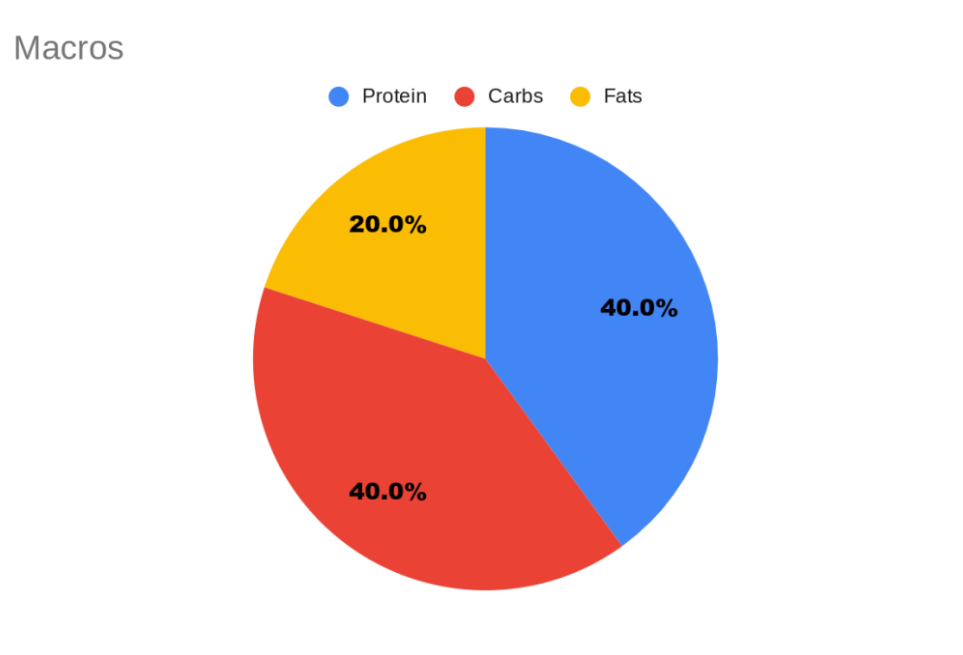Do you want to lose weight but the thought of a full-blown, long-term cutting diet for the next few months (or maybe even longer) doesn’t sound too appealing to you?
In that case, a better alternative is to go on a mini cut.
Now, if you were to google “how to do a mini cut” most of the results would probably tell you it’s the perfect opportunity to burn fat fast.
But that comes with a pretty steep tradeoff.
To do that, you’d have to really tighten up on your nutrition and drastically slash the number of calories you’re eating (which means a lot less of your favorite foods).
When I think about doing a mini cut that way I picture a runner sprinting like they’re Usain Bolt to start a mile race.
They’ll be in the lead to start, sure.
But there’s no way in hell they’ll be able to maintain an aggressive pace like that for the entire race.
Eventually, everyone will catch up and pass them.
Why?
Because the other runners chose to run at a more sustainable pace.
See what I’m getting at here?
When you’re super aggressive with cutting your calories, yes, it can help you lose fat in the short term.
But long term, you won’t be able to sustain the results because of the extreme measures you took to get there.
And if the results you achieve aren’t sustainable, can you really say it was all worth it?
Instead, I want to show you a different way to go on a mini cut–one where you can actually maintain the fat loss progress you make without sacrificing any of your favorite foods.
What is the point of a mini cut?
I touched on this briefly but let’s establish first what exactly a mini cut is.
You get better fitness results if you alternate between bulking and cutting.
And a “mini” cut is simply a shorter version of a fat loss phase (i.e. instead of being in a calorie deficit for 3, 4, 5 months at a time, your mini cut will be shorter).
It’s perfect to hit the sweet spot with fat loss where you’re like “yeah, I want to lose some body fat but I’m not looking to go on a normal 12, 16, or even 20-week cut”
How aggressive should a mini cut be?
You can go about a mini cut one of two ways:
- Cut your calories substantially low. You’d have to be a lot more strict with your diet, which means saying adios to a lot of your favorite sweets, treats, and snacks.
- Eating in a normal, moderate calorie deficit (about 300-500 calories below maintenance). This way offers you a lot more flexibility, helps you maintain a calorie deficit more comfortably, and produces results you can actually sustain.
When you’re super aggressive like with option one, it might produce quick results.
But those quick results won’t last.
In order to make your results last, what you did to get there has to be sustainable.
So, I’d go with option two.
It’s just a more practical approach.
How long should a mini cut last?
I know it’s not the best answer but there’s not really a definite, perfect amount of time for how long a mini cut should last.
It’s not like “alright then, going on a mini cut for X amount of time delivers the best results and I can’t go for a DAY longer than that.”
Fat loss (and really, life in general) isn’t always black or white.
But I’m preaching to the choir with that one.
Just pick a time limit going in (let’s say, 6-8 weeks), start with it, and go from there.
Who knows?
Maybe you’ll get into your mini cut, like how things are going, and want to extend it for a little bit longer.
How to calculate your calorie deficit for cutting
I’ve used the term “calorie deficit” a lot so far in this post.
There’s a reason for that, it’s the golden rule for weight loss.
So, what does it mean?
Being in a calorie deficit is when you burn more calories than you consume (calories out > calories in).
If you only take one thing away from this post, I want it to be this: To lose weight, you HAVE TO be in a calorie deficit.
There’s no way to avoid this.
Weight loss means being in a calorie deficit.
Period.
End of story.
Highlight this concept, star it, underline it…Just make sure you don’t forget it!
A calorie deficit is the ultimate mini cut diet plan.
What’s that you say?
You’ve been in a calorie deficit for a while now but you’re still not losing weight?
Unfortunately, that just means you’re not actually in a calorie deficit.
If you truly were, one of two things (if not both) would be happening:
- The number on the scale would be getting smaller.
- Your measurements (which you want to take every two weeks) would be decreasing.
The first step to figuring out your calorie deficit for cutting is determining the number of calories you should be eating for fat loss.
If you’ve gone on a cut before, you’ve probably been through this process already.
It’s the whole “TDEE calculator, BMR, activity level” formula.
But in case you haven’t, this post will walk you through how to calculate your deficit calories (it’ll only take you about 5 minutes).
Once you establish the number of calories you should be eating on your mini cut, you can take things one step further by breaking out those calories into macros (see the next section).
Calculating macros for a mini cut
You’ve probably heard someone say they’re “tracking their macros” but what does that really mean?
Well…
Every calorie you eat is made up of some combination of macronutrients (aka “macros”), which are just nutrients we eat the most of in our diets.
The three macronutrients are protein, carbs, and fats.
Macros are kinda like the slices of a pizza.
Some slices might be larger than others but when you add them all together, you get the full pizza.
What I mean by that is some foods might contain more protein, others–more carbs and fat.
But when you add the three macros together, you get the total number of calories in a given food.

When you count calories, you’re only concerned about total calories.
You don’t care about the macronutrient breakdown, or what makes up those calories.
So, the main question you probably have is: Why add the extra step and break out my calories into macros?
It just seems like extra work to you, and I get it.
But here’s how to think about it:
Overall calories determine weight loss while macros determine fat loss and body composition (i.e. how lean you look, how much muscle you have).
For example, if you’re not getting enough protein, it can lead to muscle loss and a less defined look.
Macro-counting is all about balance.
It helps you find that “happy medium” to where you’ll be able to make smarter food choices but at the same time, you’ll still get to enjoy your favorites while losing weight.
Personally, it wasn’t until I started tracking macros that I started to see REAL results on my fitness journey.
I’m so passionate about tracking macros and what it can do for you that I made a free PDF step-by-step guide to walk you through how to calculate your own macros for fat loss.
Just click on the picture below to snag your copy ⇩⇩⇩
What kind of foods should you eat on a mini cut?
You’re eating less than your body needs by being in a calorie deficit, so it’s only natural you’ll be a little more hungry (it’s one of the signs you’re actually in a calorie deficit).
But there’s a way to eat on a calorie deficit and then there’s a way not to eat.
Aka…Do you want to feel full and satisfied or have a constantly growling stomach?
Now, I could just list out some foods to eat while in a calorie deficit.
But if you don’t understand WHY certain foods are important for fat loss, you’ll just be limited to the lists that I or anyone else gives you.
How to workout on a mini cut
Do you judge your workouts based on any of the following?…
- How much you sweat
- How out of breath you are
- Whether or not you’re sore the next day
- How many calories your smartwatch says you burned
None of those things mean you’re having quality workouts.
So, let’s stop with the extra set of burpees you throw in at the end of your workouts because you feel like you didn’t sweat enough.
I want you to shift your mindset toward a new goal when you workout on your mini cut (and even beyond that), one that will help you achieve better results.
From here on out, don’t worry about sweating, being out of breath, or feeling sore after your workouts.
What you want to focus on instead is workout performance.
Your main goal should be using progressive overload to get stronger and lift heavier weights over time.
Why?
On a mini cut, a little muscle loss is inevitable but you want to try to offset that as much as possible with your strength training.
The more muscle you can maintain, the higher your metabolism will be.
Getting stronger and having good workout performance helps you preserve muscle.
In terms of the actual workouts themselves, your routine could be a 3-day split like this:
- Monday–Upper body
- Wednesday–Lower body
- Friday–Total body
Or, a 3-day split could be something like the push-pull-legs workout routine.
Let’s say you want to workout 4 days a week.
You’ll probably want to go with an upper/lower split.
So, that could look like:
- Monday–Lower body
- Tuesday–Upper body
- Thursday–Lower body
- Friday–Upper body
This post right here is THE ONE (seriously!) if you want to learn about how to structure your workouts and create a personalized workout plan from scratch.
I go over everything–how many exercises you should do per workout, the number of sets, the number of reps, etc.
Still, don’t forget about cardio!
When I say cardio, don’t think you have to suffer through agonizing, marathon-long sessions on the treadmill where your shirt is so drenched in sweat by the time you’re done it looks like you went outside in the middle of a storm.
Just make sure you’re getting enough daily movement throughout the day.
Yes, steps count as cardio (don’t listen to anyone who tells you otherwise).
7.5K-10K steps is ideal but if you’re not able to get that many steps in right now, 10K isn’t some magical number.
The key is to get up and move a little bit more than you may have been, and to keep building on that.
Also, you don’t have to get your steps in all at one time either, nor do they have to be during super intense exercise.
Getting your steps in could mean taking the stairs at work instead of the elevator, grocery shopping, doing yard work, walking around the house while you’re on the phone, etc.
Mistakes to avoid while on a mini cut
You’re in good shape to start your mini cut.
But when it comes to achieving (and then maintaining) fat loss, there are a few pitfalls you’ll want to look out for:
- Thinking “healthy” eating means automatic weight loss: Eating “clean” doesn’t guarantee weight loss. The only thing that guarantees that is being in a calorie deficit and burning more calories than you take in.
- Being too aggressive with your calorie deficit: Yeah, hunger is one of the signs you’re actually in a calorie deficit but you shouldn’t be so hungry that you’re on the verge of turning into dust and floating away into thin air. You think cutting your calories super low will help you lose weight quickly but this strategy just ends up backfiring and doing way more damage than good. Have a moderate deficit (this will be infinitely more sustainable) of about 300-500 calories below your maintenance.
- Looking at the weekends as a giant free-for-all: If you act like calories don’t count on the weekends, you could be undoing all the hard-earned progress you made during the week. Take up calorie cycling if you want more calories and flexibility on the weekends for fun things.
- Not sleeping enough: Sleeping more can literally make you less hungry (it increases hormones that keep you full and decreases your hunger hormones). You might have to sacrifice an episode or two from your nightly Netflix marathon but even getting just 30 minutes more a night can make a huge difference in terms of helping you control your hunger levels and giving you more energy to tackle the next day.
- Cutting out carbs or any other food group: You can still lose weight without going keto, paleo, or trying any other diet out there with a name. No, carbs don’t make you fat. Eating too many calories overall does. You can enjoy carbs, you can enjoy fats, you can enjoy any food as much as you want. As long as you make sure that you’re in a calorie deficit, you will still lose weight. Always remember that.
Mini cut FAQs
What is a mini cut vs. normal cut?
The same principles apply to both.
A mini cut gives you all the benefits of a normal cut, it’s just shorter in length.
What to do after a mini cut
The best thing to do after a mini cut is to come back up to maintenance for a couple of months or few and continue to focus on building strength.
Keep in mind you’ll weigh less at the end of a mini cut (meaning your calorie needs will have changed), so you’ll probably have to recalculate your maintenance calories.
To get your new maintenance calories, simply use this TDEE calculator.
Just enter all your info and the calculator will give you a good starting point for where your new maintenance calories are.
Mini cut wrap up
Even if you’re going on a mini cut, do you see how a more moderate approach is the key to sustainable fat loss?
Sure, you can burn fat fast if you get crazy aggressive by cutting your calories.
But raise your hand if you want a way to lose fat that ISN’T sustainable and will force you to MISS OUT on a lot of your favorite foods.
I know I kept my hand down.
When you take a more modest approach to a mini cut, one where you’re getting to eat more and enjoy more of your favorite foods, you set yourself up to not only lose fat but actually keep it off for good 💪


